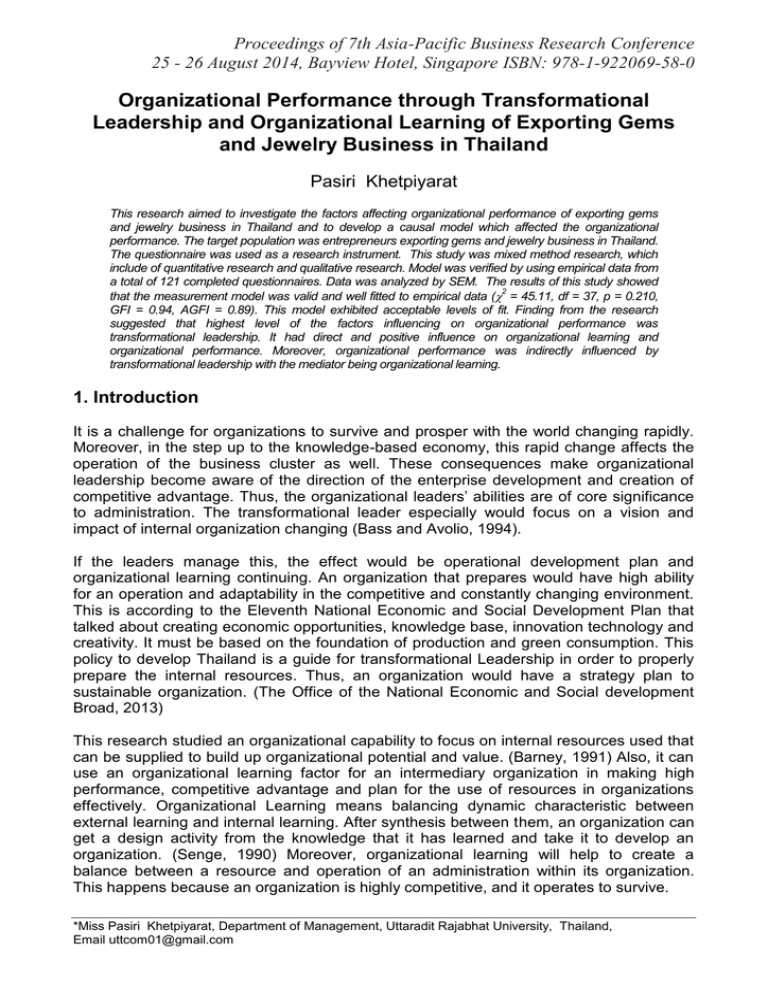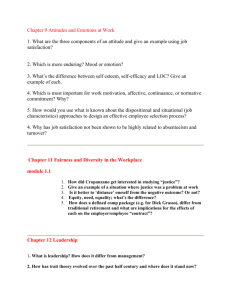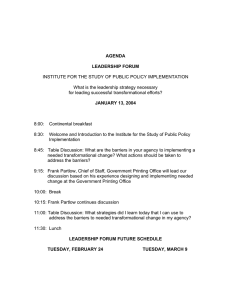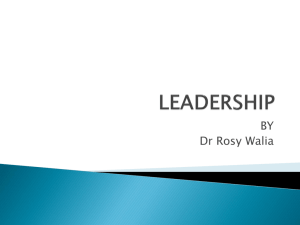
Proceedings of 7th Asia-Pacific Business Research Conference
25 - 26 August 2014, Bayview Hotel, Singapore ISBN: 978-1-922069-58-0
Organizational Performance through Transformational
Leadership and Organizational Learning of Exporting Gems
and Jewelry Business in Thailand
Pasiri Khetpiyarat
This research aimed to investigate the factors affecting organizational performance of exporting gems
and jewelry business in Thailand and to develop a causal model which affected the organizational
performance. The target population was entrepreneurs exporting gems and jewelry business in Thailand.
The questionnaire was used as a research instrument. This study was mixed method research, which
include of quantitative research and qualitative research. Model was verified by using empirical data from
a total of 121 completed questionnaires. Data was analyzed by SEM. The results of this study showed
2
that the measurement model was valid and well fitted to empirical data ( = 45.11, df = 37, p = 0.210,
GFI = 0.94, AGFI = 0.89). This model exhibited acceptable levels of fit. Finding from the research
suggested that highest level of the factors influencing on organizational performance was
transformational leadership. It had direct and positive influence on organizational learning and
organizational performance. Moreover, organizational performance was indirectly influenced by
transformational leadership with the mediator being organizational learning.
1. Introduction
It is a challenge for organizations to survive and prosper with the world changing rapidly.
Moreover, in the step up to the knowledge-based economy, this rapid change affects the
operation of the business cluster as well. These consequences make organizational
leadership become aware of the direction of the enterprise development and creation of
competitive advantage. Thus, the organizational leaders’ abilities are of core significance
to administration. The transformational leader especially would focus on a vision and
impact of internal organization changing (Bass and Avolio, 1994).
If the leaders manage this, the effect would be operational development plan and
organizational learning continuing. An organization that prepares would have high ability
for an operation and adaptability in the competitive and constantly changing environment.
This is according to the Eleventh National Economic and Social Development Plan that
talked about creating economic opportunities, knowledge base, innovation technology and
creativity. It must be based on the foundation of production and green consumption. This
policy to develop Thailand is a guide for transformational Leadership in order to properly
prepare the internal resources. Thus, an organization would have a strategy plan to
sustainable organization. (The Office of the National Economic and Social development
Broad, 2013)
This research studied an organizational capability to focus on internal resources used that
can be supplied to build up organizational potential and value. (Barney, 1991) Also, it can
use an organizational learning factor for an intermediary organization in making high
performance, competitive advantage and plan for the use of resources in organizations
effectively. Organizational Learning means balancing dynamic characteristic between
external learning and internal learning. After synthesis between them, an organization can
get a design activity from the knowledge that it has learned and take it to develop an
organization. (Senge, 1990) Moreover, organizational learning will help to create a
balance between a resource and operation of an administration within its organization.
This happens because an organization is highly competitive, and it operates to survive.
*Miss Pasiri Khetpiyarat, Department of Management, Uttaradit Rajabhat University, Thailand,
Email uttcom01@gmail.com
Proceedings of 7th Asia-Pacific Business Research Conference
25 - 26 August 2014, Bayview Hotel, Singapore ISBN: 978-1-922069-58-0
In addition, an organization should create a culture in order to build up trust between
people inside an organization (Hung, et al., 2011)
If an organization needs to develop internal processes, it is most necessary to receive
support from an organizational leader; especially a leader who practices transformational
leadership would be active and draw tacit knowledge of an employee's potential use to the
organization. Furthermore, the leader would be a supporter and developer to enhance an
employee’s ability by seeking opportunities and reducing threats in the workplace. Also,
the leader would be the structural organization designer and find the direction to build up a
sustainable organization. This data is confirmed in the study of Bass and Avolio (1994).
They concluded that the organizational leader's behaviour is very important to direct for
success or failure of an organization. This is because a leader’s behaviour and motivation
affects an employee’s operation. The same conclusion is in the study of Garcia-Morales,
et al. (2011). They have found that an organizational leader of administrative form will help
the employee to understand the significant issue of strategy that an organization uses by
studying organizational learning which helps to add value to an organization. The
transformational leadership is an important factor to support organizational learning and
set an operating plan because a leader has the authority and drive to direct followers
inside an organization in order to achieve the organizational goal.
Thailand exporting gems and jewelry business have reported an increase in revenue for
the country. This is because the businesses have the competitive ability domain,
particular skills and production skills. Although these businesses have shown high
performance, problems still arise because of a shortage of design expertise and high labor
costs when compared with China, India and Vietnam. Because of these issues, the
researcher was interested on studying organizational performance of exporting gems and
jewelry business in Thailand. The researcher wanted to find out what are causes of the
businesses needs to accelerate their potential from developing inside organizations to
survive and overcome any threat even facing the competitive and changing environment.
Factors involved in this research including the factors on organizational performance,
transformational Leadership and organizational learning. This study would help the export
of gems and jewelry businesses to have competitive potential and performance
management as a great model for the future business development.
2. Literature Review
Organizational Performance
After finishing the fiscal year for operating a business, an organization needs to know the
results of operations in the past in order to determine the operational efficiency. Dalaney
and Huselid (1996) have developed a tool to measure organizational performance. It was
using for measuring on the dimension of the market performance and human resource
performance. According to Lin and Kuo (2007) they have also used to measure the
performance in three dimensions including the financial performance, business
performance and organization effectiveness. As pointed out by Kaplan and Norton (1992)
has studied four dimensions including financial perspective, customer perspective, internal
process perspective and learning and growth perspective. In this case, the instruments
only use for measuring the performance; on the other hand, the organizational success’s
measurement has varieties. Likewise, they use to measure return on revenue such as
return on asset (ROA), return on sales (ROS) and return on equity (ROE) (Menguc, 2007;
Bobillo, 2010). Nath, et al. (2010) also has studied to use marketing measurements for
testing sales’ growth, market share growth and profitability. According to the reviewing
and analyzing elements of organizational key performance, measuring tools have various
tools as well, and each tool measures an organizational success by testing organizational
Proceedings of 7th Asia-Pacific Business Research Conference
25 - 26 August 2014, Bayview Hotel, Singapore ISBN: 978-1-922069-58-0
performance in several ways such as the performance of financial, marketing, human
resource or learning outcome. It depends on the purpose for using the measurement in
each organization. In this research, the researcher used the measurement for testing
organizational performance in two dimensions. They were financial performance including
ROS, ROA and ROE and non-financial performance including sales growth and learning
performance.
Transformational Leadership
In the study of leader’s behaviour of Bass (1990); Bass and Avolio (1994) has presented
two behaviour ideas including transactional leadership and transformational leadership.
They focused on the leader’s styles of transactional Leadership means the nature of the
leader role with maintaining the followers to perform at their best reward for performing.
However, for this research was interested and directly presented on the theory of
transformational leadership only, and this style of transformational leadership informs that
a leader who practices for transformational leadership focuses on teamwork, motivation
and creation to change for achieving the goal. Because transformational leadership
contains idealized Influence, inspiration motivation, intellectual stimulation and
individualized consideration. According to Chaiyached B. (2012), he mentioned about the
new leadership styles that is the leader’s characteristic who brings technologies and
changes for improving and developing to the sustainable organization. The way that the
leader would make it inside the organization by taking into account follows people’s needs
and well-being. In addition, the leader must create significant changes to affect the
employee and the organization as well as changes in the duty structure, strategy and
corporate culture. Also, Kriangkraiyot P. (2012) defined that the leader who has charisma
can stimulate people’s sense to feel attracted and excited to imitate the leader’s
behaviour. The way that the leader does will provide the followers’ performance by
helping them to apply their intelligence to solve the problems in order to achieve an
organizational goal. The literature review drew to interest on transformational leadership in
4 dimension. The dimensions contained inspiration motivation, intellectual stimulation,
individualized consideration and idealized Influence.
Organizational Learning
The concept of organizational learning was developed by Argyris and Chon (1996). They
showed the learning concept that learning takes place when the action is intended to
happen and cause in positive results. If problems or defects occur after inspection, the
learning will be updated for solving and developing those problems. These are important
aspects of learning. The aspects of learning are divided into two types, Single-Loop
Learning and Double-Loop Learning. According to Morgan, et al. (1998), conclude that
organizational learning that learning supports the organizational working system and
producing processes for keeping up-to-learn and up-to-date to changing environment.
Huber (1991) claim that organizational Learning is divided into four steps. The first step is
knowledge acquisition. This step tells about how people gain the knowledge, and it is the
nature of knowledge that derives from an observation, experience or learning from others.
The second step is information distribution processes on publishing, distributing and
sharing knowledge. The third step is information interpretation that information is focused
on giving a meaning, and people have information to become knowledge by gaining from
their operations’ experiences. The last step is the organizational memory that the
knowledge is kept by the storage process, and all datum and inventions are remained for
using inside the organization. This finding is similar to the study of Nemeth (1997), found
that the steps of knowledge acquisition, knowledge sharing, meaning construction,
Proceedings of 7th Asia-Pacific Business Research Conference
25 - 26 August 2014, Bayview Hotel, Singapore ISBN: 978-1-922069-58-0
organizational memory and information retrieval. Because of these literature reviews, it
has made the researcher interested in studying of organizational learning which was
containing the knowledge acquisition, information Interpretation, knowledge transfer and
integration organizational memory and retrieval of information.
3. The Methodology and Model
Measures
The measured of the organizational performance through transformational leadership and
organizational learning of gems and jewelry business in Thailand with the variables used
including:
Transformational leadership measured by the four indicators including inspiration
motivation, intellectual stimulation, individualized consideration and idealized influence.
Organizational learning measured by the four indicators including knowledge acquisition,
information interpretation, knowledge transfer and integrating, organizational memory and
retrieval of information.
Organizational performance measured by the two indicators including financial
performance and non-financial performance.
Sample and Data
The study is carried on Thailand exporting gem and jewelry business that scope was the
CEO or executives of the companies. All companies registered as a member of the
Department of International Trade Promotion (Department of International Trade
Promotion, 2013) in a total of 387 companies. They are companies to work on exporting of
gems and jewelry. The businesses’ names are in the database of the Department of
International Trade Promotion and establishment on the form of producing and
manufacturing in Thailand. Questionnaires and the structured interview were used as the
primary means for data collection using in-depth interviews and mailed questionnaires.
During the study period focused on a measurement model that influence on organizational
performance of exporting gems and jewelry business in Thailand, and studying was to
review theories and related researches. The research had qualitative research technique
that was in-depth interviews with entrepreneurs in exporting companies of gems and
jewelry in Thailand. In addition, Quantitative research technique analyzed with SEM
(Structural Equation Modeling). The data collection used the questionnaires to distribute to
the sampling group and analyzed
The review of the literatures, it was concluded that organizational performance was
caused by the administration of the leader who practice transformational Leadership;
whereas, the organizational learning arose from the direct and indirect experiences of the
followers. If the leader who practices transformational leadership orders organizational
learning, the organizational performance would be high level of efficiency and
effectiveness.
Proceedings of 7th Asia-Pacific Business Research Conference
25 - 26 August 2014, Bayview Hotel, Singapore ISBN: 978-1-922069-58-0
The Conceptual Framework and the Hypotheses
Organizational Learning
H2
Transformational
Leadership
-Inspiration Motivation
-Intellectual Stimulation
-Individualized Consideration
-Idealized Influence
-Knowledge Acquisition
-Information Interpretation
-Knowledge Transfer and
Integration
-Organizational Memory
-Retrieval of information
H3
H1
Organizational Performance
-Financial Performance:
ROS, ROA, ROE
-Non-Financial Performance
Market Performance
Sales Growth, Learning
Performance
Figure 1 Research Framework
4. The Findings
The findings were the causal factors that influenced on organizational performance of
exporting gems and jewelry in Thailand. The details were as following:
The result of factors influenced the direct and indirect effects on the organizational
performance of exporting gems and jewelry in Thailand.
Table 1 showing the cause factors influenced the organizational performance of exporting
gems and jewelry in Thailand
Latent Variable
Transformational
Leadership
Observed Variable
-Inspiration Motivation
-Intellectual Stimulation
-Individualized
Consideration
-Idealized Influence
Direct Effect
/
Organizational
Learning
-Knowledge Acquisition
-Information
Interpretation
-Knowledge Transfer
and Integration
-Organizational Memory
-Retrieval of information
/
Indirect Effect
trough
Organizational
Learning
The result of factors influenced organizational performance of exporting of gems and
jewelry business in Thailand. In order to enable the construction of transformational
leadership and organizational learning were direct effect of organizational performance;
moreover, transformational leadership also has indirect effect of organizational
performance through organizational learning.
Proceedings of 7th Asia-Pacific Business Research Conference
25 - 26 August 2014, Bayview Hotel, Singapore ISBN: 978-1-922069-58-0
The result of factors influenced organizational performance by testing the consistency of
the measurement model, and the model also influenced organizational performance of
exporting gems and jewelry in Thailand. The result showed that the model was verified by
using the empirical data. Considering this study showed that the measurement model was
valid and well fitted to the empirical data with the chi-square (2) was 45.11, degree of
freedom (df) was 37, p-value (p) was 0.210, Goodness-of-Fit Index (GFI) was 0.94,
Adjusted Goodness-of-Fit Index (AGFI) was 0.89, Root Mean Square Residuals (RMR)
were 0.017 and Root Mean Square Error of Approximation (RMSEA) was 0.039. The chi-square
relative (2/df) was 1.22 which was less than 2.
Finding from the research suggested that highest level of the factors influencing on
organizational performance (E2) was transformational leadership (K1). It had direct and
positive influence on organizational learning (E1) and organizational performance. (E2)
Moreover, organizational performance (E2) was indirectly influenced by transformational
leadership (K1) with the mediator being organizational learning (E1). Whereas,
transformational leadership (K1) had total effect and direct effect equal to 0.71 and 0.68
respectively, it had indirect effect on organizational performance (E2) through
organizational learning (E1), with the size of indirect effect equal to 0.18. Thus, all of these
were the value of influence in the statistical significance on 0.01 and 0.05. The analysed result
can show on the table 2 as following:
Proceedings of 7th Asia-Pacific Business Research Conference
25 - 26 August 2014, Bayview Hotel, Singapore ISBN: 978-1-922069-58-0
Table 2 showing the analyzing results were the factors influenced the organizational
performance of exporting gems and jewelry in Thailand.
Effect factors
Transformationa
l Leadership
Organizational
Learning
R2
Cause Factors
Organizational Learning
.51
DE
.71**
IE
-
TE
.71**
.77
-
-
-
Organizational
Performance
DE
IE
TE
.68**
.18**
.86**
.24**
-
.24**
*The Chi Square = 45.11, df = 37, p = 0.210, GFI = 0.94, AGFI = 0.89, RESEA = 0.039
5. Summary and Conclusions
H1: The transformational leadership that had direct and positive influence on
organizational performance.
This was confirmed in the concept of Bass and Avolio (1994). They found that the
behaviour of the leader who practices transformational leadership is more affective to
followers in an attempt for having high performance than the leader who practices
transactional leadership. Moreover, the leader acts to provide opportunities to followers to
debate or ask questions, these makes good and high level of organizational performance.
The research result was consistent with the study of Robbins and Coulter (2007). They
presented that the leader who practices transformational leadership can create and
generate more productive and higher operation of the organizational performance than the
leader who practices transactional leadership. This is because the leader supports to
make organizational productivity, generate new ideas and effort employees’ on the job
satisfaction. As a result, the organization can achieve the organizational objectives and
goal setting. These literatures were verified the research results that the leaders of
exporting of gems and jewelry business in Thailand who practiced transformational
leadership must set their administrative guidelines to be suitable on their employees’
need. In addition, leaders must encourage employees to practice for their perception and
learning from the organizational leaders’ information. Leaders must inspire with
challenging assignments to employees, develop their learning and allow them to express
their creativities. Leaders must be as a good role model as well as paying more attention
and caring in all staffs closely. If the guidelines were accepted by everyone in the
organization, it would have the result of the collaborative working on high performance.
Besides, this research was also consistent with the study of Garcia-Morales, et al. (2011).
The study showed that transformational leadership directly affects the results of
organizational operations. The leader who practices transformational leadership would
encourage employees to perceive and learn to have responsibilities on their jobs. Thus,
Thailand exporting companies of gems and jewelry must design their administrations to be
an appropriate depending on the context of the organizational and personnel needs.
H2 : Transformational leadership was direct and positive influence organizational
learning.
Transformational leadership was factors that had direct and positive influence on
organizational learning. This result is confirmed in the study of Gemusluogo and Ilsev
(2009). They found that to achieve a better relationship among people inside the
organization is the duty of the leader. The leader gives an opportunity and motivation to
their followers that they will be creators to find creative ways working, and the leader also
helps them to fulfill the employees' knowledge continuously. Moreover, the leader who
Proceedings of 7th Asia-Pacific Business Research Conference
25 - 26 August 2014, Bayview Hotel, Singapore ISBN: 978-1-922069-58-0
interests in information and learns from what is around the organization enables to help
the organization having knowledge and apply it for getting a high advantage in order to
contain the organization's ability to survive. This study was consistent with the study of
Menquc, et al., (2007); Garcia-Morales, et al., (2011). They showed that transformational
leadership supports learning and take an advantage from the marketing strategy which is
marketing differentiation. These are result to make an affect organizational growth and
competitive advantage. Furthermore, the leader who practices transformation leadership
should use the knowledge sharing by giving the opportunity to employees for sharing their
ideas and brainstorming to analyze information from external organization frequently. The
information should get from external organization and customers. Furthermore, the leader
should support organizational learning and present an importance of continuing learning in
among of employees. If employees were curious of leaning, it would help them to have a
persuasion in order to develop their skills and abilities. This would provide to develop an
individual fist before distributing to the group working and the whole organization in the
last. Thus, organizational learning would be benefit to organizational performance as a
good direction to achieve the goal.
H3 : Organizational learning was factors that had direct and positive influence on
organizational performance.
The finding showed that learning process comprised knowledge acquisition, information
interpretation, knowledge transfer and Integration, organizational memory and retrieval of
information (Huber, 1991; Jimenez and Valle, 2011). In each organization has a unique
way to manage organizational learning differently. Starting from an acquisition of
knowledge is knowledge finding in the different sources of knowledge to enhance
operational capabilities (Rhodes, et al., 2008). The reason for organizational learning is
beneficial for increasing organizational performance with the leader who understand the
workplace environment and cope in the right way of organizational management (Jones,
2000). This study was consistent with the concept of Liao and Wu (2008). They found that
creating the recognition system among employees can help them to create their learning
path with their experiences. Also receiving the knowledge from the organization will help
them apply their knowledge to make more benefit to the organization. Moreover, learning
process in an organization starts by creating learning, and it occur from integrating
knowledge inside an organization to use the knowledge in the top to the maximum benefit
for the organization, and the knowledge is published or distributed through the entire
organization and retrieval of information Migdadi (2009) in order to use it for value adding
of the organizational output and outcome.
Implication for Operating
The results found that the behaviour of the leader who practiced transformational
leadership was significant to increase the organizational performance. This is because the
leader is a key factor in an organizational success with behaviour aspects on vision,
foresight and change to an organization. Also, the leader influences the concept and
practice among employees. Unlike, the leader who practiced transactional leadership was
only focusing on using incentives workforces in many ways. Thus, an organizational
leader should practice a new leadership model in the form of transformational leadership
to manage in the organization because this type of leadership would have a vision that
could bring the development and change to organization.
To give high organizational performance, the leaders should encourage everyone for
practicing on organizational learning. This is because the survival and prosperity of an
organization base on the lives of their learning. Organizational learning has dimensions of
leaning including information, critical corporate data or practice techniques. These confirm
Proceedings of 7th Asia-Pacific Business Research Conference
25 - 26 August 2014, Bayview Hotel, Singapore ISBN: 978-1-922069-58-0
that an organization should prepare for organizational learning, and could be done by the
leader who encourages people and adopt the information technology system in the
organization. An organization will get the benefit from working on these in various fields
such as the telecommunication, data storage, specific production of the organization, and
finally it becomes the source of organizational knowledge. The leader needs to focus on
learning process and support the use of the information technology to help for enhancing
operational performance and maintain the knowledge continuing with the organization.
Future Research
This research focused on a specific target group of the top executives in exporting gems
and jewelry business in Thailand. This research was studying only in the perspective of
administrators. In the future research, it should be study on the organization's
stakeholders such as employees, customers and shareholders to achieve more
comprehensive study.
This research focused to study factors that influenced organizational performance
containing only on transformational leadership, organizational learning and organizational
performance of exporting gems and jewelry business in Thailand. Thus, the future
research should study on other factors such as a production, innovation or information
technology system.
References
Argyris C and Schon DA 1996, Organizational learning II: Theory, Method, and Practice,
London: Addison-Wesley.
Barney JB 1991, Firm resources and sustainable competitive advantage. Journal of
Management, Vol. 17, No. 1, pp.99 – 120.
Bass BM 1990, Bass and Stodgill's handbook of leadership. New York: Free Press.
Bass BM and Avolio BJ 1994, Improving organizational effectiveness through
transformational leadership, Thousand Oaks, CA : Sage.
Bobillo AM 2010, Firm performance and international diversification : The internal and
external competitive advantages, International Business Review, Vol. 19,
pp. 607 – 618.
Chaiyached Brahmmasi 2007, Organizational Leadership, Bangkok, Expernet , Thailand.
Delaney JT and Huselid M A 1996, The impact of human resource management practices
on perception of organizational performance. Academy of management Journal,
Vol. 39, No. 4, pp.949-969.
Department of International Trade Promotion, 2013, Exporter Directory, Thailand, on-line,
http://application.ditp.go.th/Center_Public/thailand_export_directory.html
Department of International Trade Promotion, Exporter's Directory, on-line, 2013,
http://112.121.130.212/Home/%E0%B8%AB%E0%B8%99%E0%B8%B2%E0%B
9%81%E0%B8%A3%E0%B8%81/tabid/437/Default.aspx
Garcia-Morales V J Jimenez-Barrionuevo MM and Gutierrez-Gutierrez L 2011,
Transformation leadership, creativity, and organizational innovation, Journal of
Business Research, Vol. 62, pp.461 -473.
Gemusluoglo L and Ilsev A 2009, Transformation leadership, creativity, and
organizational innovation, Journal of Business Research, Vol. 62, pp. 461-473.
Huber GP 1991, Organizational learning: the contributing process and literatures,
Organization Science, Vol. 2, No.1, pp.97-120.
Hung RY Lien BY Yang B Wu C and Kuo Y 2011, Impact of TQM and organizational
learning on innovation performance in the high-tech industry, International
Business Review, Vol. 20, pp. 213 – 225.
Proceedings of 7th Asia-Pacific Business Research Conference
25 - 26 August 2014, Bayview Hotel, Singapore ISBN: 978-1-922069-58-0
Jimenez- Jimenez D and Sanz-Valle R 2011, Innovation, Organizational learning, and
performance Journal of Business Research, Vol. 64, No. 4, pp. 408-471.
Jones, GR 2000, Organizational Theory (3rd ed.). New York: Prentice-Hall.
Kaplan, R. and Norton, D. (1992). The balanced scorecard: measures that drive
performance. Harvard Business Review, 70, 71-79.
Kriengkriyos Punthai 2009, The Influence of Leadership Behaviours, Organizational
Culture and human Resource Development on Employee Performance in State
Enterprises. Ph.D. Dissertation, NIDA University, Thailand.
Liao SH and Wu CC 2008, System perspective of knowledge management,
organizational learning, and organizational innovation. Expert Systems with
Applications, Vol. 37, pp. 1096–1103.
Lin CY and Kuo TH 2007, The mediate effect of learning and knowledge on
organizational performance, Industrial management & data systems, Vol. 107, No.
7, pp. 1066-1083.
Menguc B Auh S and Shih E 2007, Transformational leadership and market orientation :
Implications of the implementation of competitive strategies and business unit
performance. Journal of Business Research, Vol. 60, pp. 314–321.
Migdadi MM 2009, A knowledge-centered culture as an antecedent of effective
knowledge management at information technology centers in the Jordanian
Universities. Journal of Systems and Information Technology, Vol. 11, No. 2,
pp. 89–116.
Morgan RE Katsikeas CS.and Appiah-ADu K 1998, Market orientation and organizational
learning capabilities, Journal of Marketing Management, Vol. 14, pp. 353– 381.
Nath P Nechiappan S and Ramanathan R 2010, The impact of marketing capability and
diversification strategy on performance: A resource-based view. Industrial
Marketing Management, Vol. 39, pp. 317-329.
Nemeth, L 1997, Measuring Organizational Learning. The University of Western Ontario.
London: Faculty of Graduate Studies.
Rhodes J Lok P Kung RYY and Fang SC 2008, An integrative model of organizational
learning and social capital on effective knowledge transfer and perceived
organizational performance. Journal of Workplace Learning, Vol. 20 No. 4, pp.
245-258.
Robbins SP and Coulter M 2007, Management (9 th ed.). New Jersy: Pearson Prentice
Hall.
Senge PM 1990, The fifth discipline: the art & practice of the learning organization.
London: Random House.
The Office of the National Economic and Social Development Broad, The Eleventh
National Economic and Social Development Plan (2012 - 2016) 2013, on-line,
http://www.nesdb.go.th/Default.aspx?tabid=395.




